#kit walsh
Text
Good riddance to the Open Gaming License
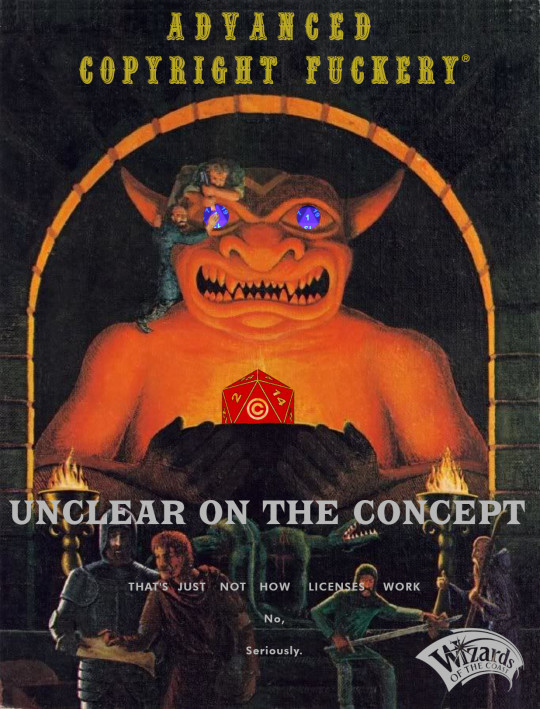
Last week, Gizmodo’s Linda Codega caught a fantastic scoop — a leaked report of Hasbro’s plan to revoke the decades-old Open Gaming License, which subsidiary Wizards Of the Coast promulgated as an allegedly open sandbox for people seeking to extend, remix or improve Dungeons and Dragons:
https://gizmodo.com/dnd-wizards-of-the-coast-ogl-1-1-open-gaming-license-1849950634
The report set off a shitstorm among D&D fans and the broader TTRPG community — not just because it was evidence of yet more enshittification of D&D by a faceless corporate monopolist, but because Hasbro was seemingly poised to take back the commons that RPG players and designers had built over decades, having taken WOTC and the OGL at their word.
Gamers were right to be worried. Giant companies love to rugpull their fans, tempting them into a commons with lofty promises of a system that we will all have a stake in, using the fans for unpaid creative labor, then enclosing the fans’ work and selling it back to them. It’s a tale as old as CDDB and Disgracenote:
https://en.wikipedia.org/wiki/CDDB#History
(Disclosure: I am a long-serving volunteer board-member for MetaBrainz, which maintains MusicBrainz, a free, open, community-managed and transparent alternative to Gracenote, explicitly designed to resist the kind of commons-stealing enclosure that led to the CDDB debacle.)
https://musicbrainz.org/
Free/open licenses were invented specifically to prevent this kind of fuckery. First there was the GPL and its successor software licenses, then Creative Commons and its own successors. One important factor in these licenses: they contain the word “irrevocable.” That means that if you build on licensed content, you don’t have to worry about having the license yanked out from under you later. It’s rugproof.
Now, the OGL does not contain the word “irrevocable.” Rather, the OGL is “perpetual.” To a layperson, these two terms may seem interchangeable, but this is one of those fine lawerly distinctions that trip up normies all the time. In lawyerspeak, a “perpetual” license is one whose revocation doesn’t come automatically after a certain time (unlike, say, a one-year car-lease, which automatically terminates at the end of the year). Unless a license is “irrevocable,” the licensor can terminate it whenever they want to.
This is exactly the kind of thing that trips up people who roll their own licenses, and people who trust those licenses. The OGL predates the Creative Commons licenses, but it neatly illustrates the problem with letting corporate lawyers — rather than public-interest nonprofits — unleash “open” licenses on an unsuspecting, legally unsophisticated audience.
The perpetual/irrevocable switcheroo is the least of the problems with the OGL. As Rob Bodine— an actual lawyer, as well as a dice lawyer — wrote back in 2019, the OGL is a grossly defective instrument that is significantly worse than useless.
https://gsllcblog.com/2019/08/26/part3ogl/
The issue lies with what the OGL actually licenses. Decades of copyright maximalism has convinced millions of people that anything you can imagine is “intellectual property,” and that this is indistinguishable from real property, which means that no one can use it without your permission.
The copyrightpilling of the world sets people up for all kinds of scams, because copyright just doesn’t work like that. This wholly erroneous view of copyright grooms normies to be suckers for every sharp grifter who comes along promising that everything imaginable is property-in-waiting (remember SpiceDAO?):
https://onezero.medium.com/crypto-copyright-bdf24f48bf99
Copyright is a lot more complex than “anything you can imagine is your property and that means no one else can use it.” For starters, copyright draws a fundamental distinction between ideas and expression. Copyright does not apply to ideas — the idea, say, of elves and dwarves and such running around a dungeon, killing monsters. That is emphatically not copyrightable.
Copyright also doesn’t cover abstract systems or methods — like, say, a game whose dice-tables follow well-established mathematical formulae to create a “balanced” system for combat and adventuring. Anyone can make one of these, including by copying, improving or modifying an existing one that someone else made. That’s what “uncopyrightable” means.
Finally, there are the exceptions and limitations to copyright — things that you are allowed to do with copyrighted work, without first seeking permission from the creator or copyright’s proprietor. The best-known exception is US law is fair use, a complex doctrine that is often incorrectly characterized as turning on “four factors” that determine whether a use is fair or not.
In reality, the four factors are a starting point that courts are allowed and encouraged to consider when determining the fairness of a use, but some of the most consequential fair use cases in Supreme Court history flunk one, several, or even all of the four factors (for example, the Betamax decision that legalized VCRs in 1984, which fails all four).
Beyond fair use, there are other exceptions and limitations, like the di minimis exemption that allows for incidental uses of tiny fragments of copyrighted work without permission, even if those uses are not fair use. Copyright, in other words, is “fact-intensive,” and there are many ways you can legally use a copyrighted work without a license.
Which brings me back to the OGL, and what, specifically, it licenses. The OGL is a license that only grants you permission to use the things that WOTC can’t copyright — “the game mechanic [including] the methods, procedures, processes and routines.” In other words, the OGL gives you permission to use things you don’t need permission to use.
But maybe the OGL grants you permission to use more things, beyond those things you’re allowed to use anyway? Nope. The OGL specifically exempts:
Product and product line names, logos and identifying marks including trade dress; artifacts; creatures characters; stories, storylines, plots, thematic elements, dialogue, incidents, language, artwork, symbols, designs, depictions, likenesses, formats, poses, concepts, themes and graphic, photographic and other visual or audio representations; names and descriptions of characters, spells, enchantments, personalities, teams, personas, likenesses and special abilities; places, locations, environments, creatures, equipment, magical or supernatural abilities or effects, logos, symbols, or graphic designs; and any other trademark or registered trademark…
Now, there are places where the uncopyrightable parts of D&D mingle with the copyrightable parts, and there’s a legal term for this: merger. Merger came up for gamers in 2018, when the provocateur Robert Hovden got the US Copyright Office to certify copyright in a Magic: The Gathering deck:
https://pluralistic.net/2021/08/14/angels-and-demons/#owning-culture
If you want to learn more about merger, you need to study up on Kregos and Eckes, which are beautifully explained in the “Open Intellectual Property Casebook,” a free resource created by Jennifer Jenkins and James Boyle:
https://web.law.duke.edu/cspd/openip/#q01
Jenkins and Boyle explicitly created their open casebook as an answer to another act of enclosure: a greedy textbook publisher cornered the market on IP textbook and charged every law student — and everyone curious about the law — $200 to learn about merger and other doctrines.
As EFF Senior Staff Attorney Kit Walsh writes in her must-read analysis of the OGL, this means “the only benefit that OGL offers, legally, is that you can copy verbatim some descriptions of some elements that otherwise might arguably rise to the level of copyrightability.”
https://www.eff.org/deeplinks/2023/01/beware-gifts-dragons-how-dds-open-gaming-license-may-have-become-trap-creators
But like I said, it’s not just that the OGL fails to give you rights — it actually takes away rights you already have to D&D. That’s because — as Walsh points out — fair use and the other copyright limitations and exceptions give you rights to use D&D content, but the OGL is a contract whereby you surrender those rights, promising only to use D&D stuff according to WOTC’s explicit wishes.
“For example, absent this agreement, you have a legal right to create a work using noncopyrightable elements of D&D or making fair use of copyrightable elements and to say that that work is compatible with Dungeons and Dragons. In many contexts you also have the right to use the logo to name the game (something called “nominative fair use” in trademark law). You can certainly use some of the language, concepts, themes, descriptions, and so forth. Accepting this license almost certainly means signing away rights to use these elements. Like Sauron’s rings of power, the gift of the OGL came with strings attached.”
And here’s where it starts to get interesting. Since the OGL launched in 2000, a huge proportion of game designers have agreed to its terms, tricked into signing away their rights. If Hasbro does go through with canceling the OGL, it will release those game designers from the shitty, deceptive OGL.
According to the leaks, the new OGL is even worse than the original versions — but you don’t have to take those terms! Notwithstanding the fact that the OGL says that “using…Open Game Content” means that you accede to the license terms, that is just not how contracts work.
Walsh: “Contracts require an offer, acceptance, and some kind of value in exchange, called ‘consideration.’ If you sell a game, you are inviting the reader to play it, full stop. Any additional obligations require more than a rote assertion.”
“For someone who wants to make a game that is similar mechanically to Dungeons and Dragons, and even announce that the game is compatible with Dungeons and Dragons, it has always been more advantageous as a matter of law to ignore the OGL.”
Walsh finishes her analysis by pointing to some good licenses, like the GPL and Creative Commons, “written to serve the interests of creative communities, rather than a corporation.” Many open communities — like the programmers who created GNU/Linux, or the music fans who created Musicbrainz, were formed after outrageous acts of enclosure by greedy corporations.
If you’re a game designer who was pissed off because the OGL was getting ganked — and if you’re even more pissed off now that you’ve discovered that the OGL was a piece of shit all along — there’s a lesson there. The OGL tricked a generation of designers into thinking they were building on a commons. They weren’t — but they could.
This is a great moment to start — or contribute to — real open gaming content, licensed under standard, universal licenses like Creative Commons. Rolling your own license has always been a bad idea, comparable to rolling your own encryption in the annals of ways-to-fuck-up-your-own-life-and-the-lives-of-many-others. There is an opportunity here — Hasbro unintentionally proved that gamers want to collaborate on shared gaming systems.
That’s the true lesson here: if you want a commons, you’re not alone. You’ve got company, like Kit Walsh herself, who happens to be a brilliant game-designer who won a Nebula Award for her game “Thirsty Sword Lesbians”:
https://evilhat.com/product/thirsty-sword-lesbians/
[Image ID: A remixed version of David Trampier's 'Eye of Moloch,' the cover of the first edition of the AD&D Player's Handbook. It has been altered so the title reads 'Advanced Copyright Fuckery. Unclear on the Concept. That's Just Not How Licenses Work. No, Seriously.' The eyes of the idol have been replaced by D20s displaying a critical fail '1.' Its chest bears another D20 whose showing face is a copyright symbol.]
#pluralistic#copyfraud#wizards of the coast#wotc#dungeons and dragons#d&d#ogl#open gaming license#eff#fair use#kit walsh#consideration#licenses
8K notes
·
View notes
Note
Happy WIP Wednesday! Person pit or homeboy and honey?
PERSON PIT!
"Your eyes better be on the sea, Walsh," Barb said.
"They are, don't worry," Kit said, turning his head back towards the window.
"Kit, would you like some rappie pie?" Zaynab asked.
"Nah, not a fan," she responded. "Don't worry about me, I already ate."
"Alright," Zaynab said.
She sat down on a rickety wicker stool beside one of the arching windows that faced The Pit. She didn't really understand why they called it a pit. It looked more like a cave system that was just a tad above ground. There were tunnels that poked out of the ground, the entrances so thin that Zaynab was barely able to crawl through the gap when The Pit took her. The largest entrance that most people came out of faced Barb's lighthouse, but the other eight entrances formed a circle around a sunken-in patch of grass with a couple mushrooms in it. Maybe that's why it was called a pit: the land in the center of the tunnels sagged so low, it became a pond every time it rained. But nobody came out of that part, they came out of the tunnels.
#banesball#nova scotia lookouts#barbie nebuchadnezzar#zaynab campbell#kit walsh#wip wednesday works#asks 4 sasha#orble writing
4 notes
·
View notes
Text
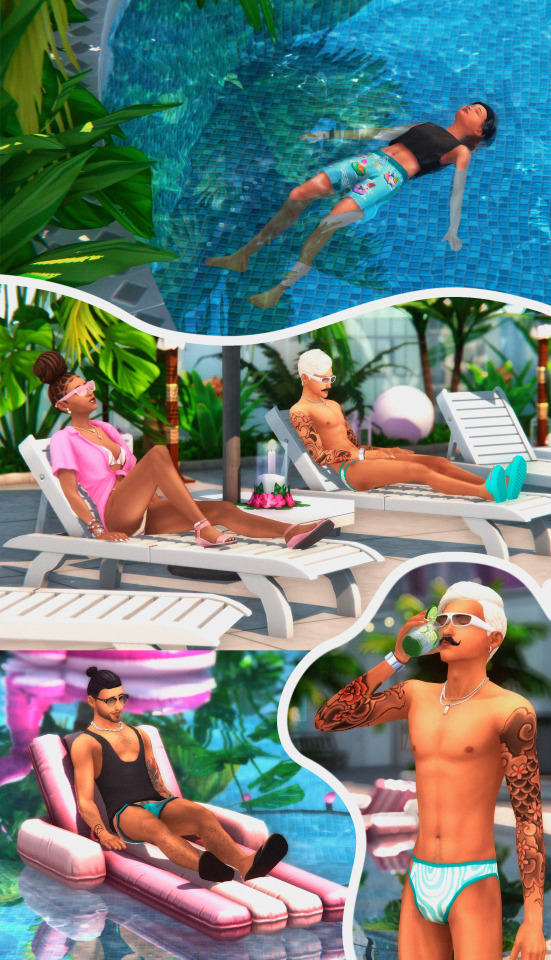

summer in san myshuno ☀
#ts4#sims 4#simblr#ts4 edit#ts4 screenshots#ts4 vanilla#darling walsh#miko ojo#akira kibo#penny pizzazz#diego lobo#karaoke legends#ts4 townies#vanillalookz#a#this took me longer than i'd like to admit............ and for what#anyways the kit's very cute i love a free update am i rite#editz
226 notes
·
View notes
Text

Love that Keira and Georgia have basically been adopted by the Austrians!
#personally I’d put her in a slightly different colour cardigan#BUT do love the cardigan lifestyle#also Laura looking gorge AS PER#those kits are fire#sorry rambling just love the pic#keira walsh#laura feiersinger
61 notes
·
View notes
Text
that blue kit is a curse fr but aside from that 😭😭 we really need leah, viv, beth and keira on the pitch like rn 😭 i don't think i ever missed kei and lee this much, man.
#woso#woso community#arsenal#awfc#leah williamson#keira walsh#vivianne miedema#beth mead#lionesses#arsenalwfc#leah catherine williamson#crying screaming sliding down the wall#shitting crying throwing up#i miss them#so fucking much#t^t#blue kit is a curse#that blue mf kit#blue my fav color but man 😞👊🏻#bring them back#like right now#please istg
43 notes
·
View notes
Text


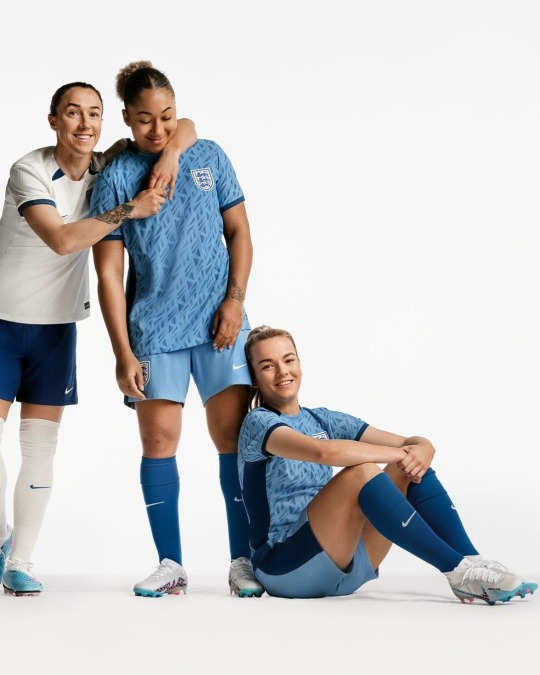
#this kit kinda slaps ngl#definitely not adidas level slaps but still#also leah's hair?? love#lionesses#engwnt#chloe kelly#leah williamson#ella toone#keira walsh#georgia stanway#lucy bronze#lauren james#lauren hemp
129 notes
·
View notes
Photo



Swordfighting and sapphic yearning lie at the core of Thirsty Sword Lesbians, as players are encouraged to engage with roleplaying partners and non-player characters through shared emotional connections. While coming to blows is a common occurrence in the tabletop RPG system, far more important to the flow of combat is how characters share who they are with each other, and this is baked into the heart of the rules themselves, as players are encouraged to build their characters up over time into better, kinder, and most importantly, more just individuals.
34 notes
·
View notes
Text
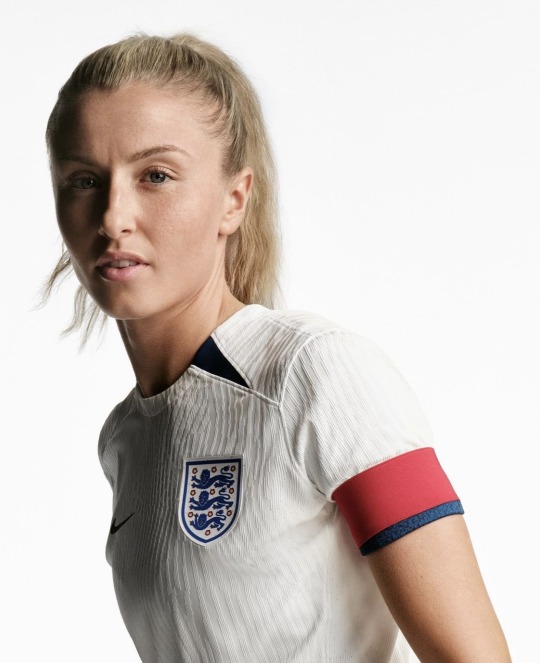


sheesh 🔥 😅
39 notes
·
View notes
Text
Excuse me but where are these Rom-Coms? I need them in my life!
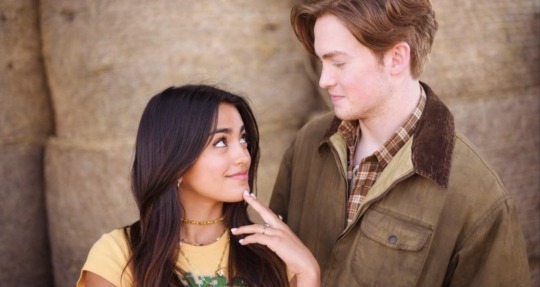
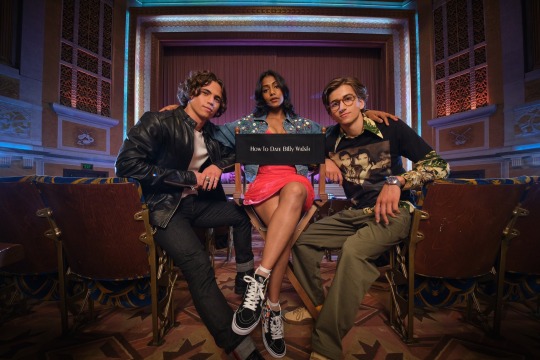
#kit connor#sebastian croft#orion maxwell#Archie#a cuban girl's guide to tea and tomorrow#how to date billy walsh#heartstopper
35 notes
·
View notes
Text

For the nineteenth game, Roll plus heart is returning to the game that started it all, Thirsty Sword Lesbians by April Kit Walsh. The first episode is out today as we jump back into the lives of Jaz, Juniper and Tiddles six months after their victory on Mytilene. Will the players somehow be even more chaotic? Will I remember to ask people to roll dice? Listen and find out.
3 notes
·
View notes
Text
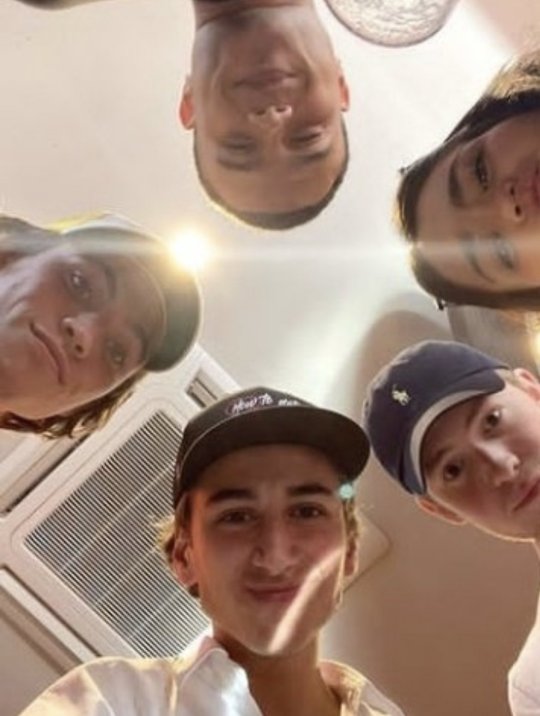
Bash with Samuel, Tanner, Kit and Maia
30 notes
·
View notes
Text

#honestly if every heartstopper cast member did a different romcom i wouldn’t mind#this looks great#and all three of them are beautiful#it's an interesting coincidence how both kit and bash filmed different romcoms at the same place at the same time#heartstopper cast#sebastian croft#tanner buchanan#charithra chandran#how to date billy walsh
29 notes
·
View notes
Note
PERSON PIT!!!!!
sorry it took me 5ever to get to this. im soooooooooooooo brain foggy (as of writing this; im queueing this post to post at a Normal Time)
She sat down on a rickety wicker stool beside one of the arching windows that faced The Pit. She didn't really understand why they called it a pit. It looked more like a cave system that was just a tad above ground. There were tunnels that poked out of the ground, some of the entrances so thin that Zaynab wasn't sure if anyone besides a small child could fit through it.. The largest entrance that most people came out of faced Barb's lighthouse, but the other eight entrances formed a circle around a sunken-in patch of grass with a couple mushrooms in it. Maybe that's why it was called a pit: the land in the center of the tunnels sagged so low, it became a pond every time it rained. But nobody came out of that part, they came out of the tunnels. Partially the largest one.
Out of the corner of her eye, something moved. Zaynab's attention snapped in that direction: one of the membranous tunnel entrances was pulsating.
"Um, Barb?" Zaynab asked.
"Whatcha want?" Barb grumbled.
"Has anyone ever come out of a tunnel other than the main one?"
#wip wednesday works#asks 4 sasha#banesball#bnsb: barbie nebuchadnezzar#bnsb: zaynab campbell#bnsb: kit walsh#bnsb: person pit#orble writing
6 notes
·
View notes
Link
Mary's Monster is a strikingly original, high-concept rock ‘n roll take on Mary Shelley’s mental struggle to write her seminal novel Frankenstein. Starring Kit Harington as The Monster, Clara Rugaard as Mary Shelley, Ferdia Walsh-Peelo as Percy Bysshe Shelley, and Sebastian de Souza as Lord Byron.
This genre-busting film brings to life the monster like never before, appearing to Mary as the manifestation of her own fragile and damaged psyche. Re-imagining the anarchic, turbulent, hedonistic spirit of the Romantic era, Mary’s Monster will redefine period film for the modern YA audience.
#legion m#fulwell 73#rose pictures#mary's monster#kit harington#clara rugaard#ferdia walsh peelo#sebastian de souza#farren blackburn#rose ganguzza#leo pearlman#heather greenwood#james corden#movies#frankenstein#books#coming soon
3 notes
·
View notes
Text
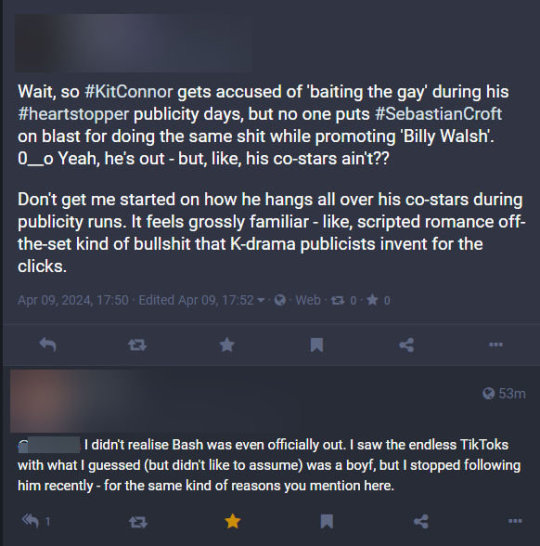


[IMAGES] Screengrab of conversation on Mastodon.
[Image 1 - Unknown User: Wait, so Kit Connor gets accused of 'baiting the gay' during his heartstopper publicity days, but no one puts Sebastian Croft on blast for doing the same shit while promoting 'Billy Walsh.' 0__o Yeah, he's out - but, like, his co-stars ain't?? Don't get me started on how he hangs all over his co-stars during publicity runs. It feels grossly familiar - like, scripted romance off-the-set kind of bullshit that K-drama publicists invent for the clicks.]
[Image 2 - Unknown User Reply: I didn't realise Bash was even officially out. I saw the endless TikToks with what I guessed (but didn't like to assume) was a boyf, but I stopped following him recently - for the same kind of reasons you mention here.]
[Image 3 - Unknown User: I assume everyone’s bi until they tell me different 😆 but like, how is he getting away with this shit but Connor gets dragged for it? I still laugh at that video where Locke, Connor, and Croft, are watching scenes from HS and Connor literally chides Croft for flirting with him. 😆 ]
Image 4 - Unknown User Reply: I guess because more people assumed that Croft was queer, but that Connor wasn't, when HS aired. And some may *still* believe that despite Connor's fuck-you-all-I'm-bi tweet, and Croft's vagueness. Hence for Croft it's confirming what everyone assumed so ~whatever~, but Connor was just a "straight boy putting on an act". Plus some people conflating Kit with Nick, drinking the parasocial KoolAid, and feeling entitled to have him tick the gay box so they think they have a chance.
[Image 5 - Unknown User: the parasocial shit annoys me. There’s two of those wakadoos over at LPSG on the Joe Locke thread – which is the bitchiest thread I’ve ever left. 😓 1/2 ]
[Image 6 - Unknown User: 2/2 As an aging fujo/fudan, it makes me cringe. True Fu's enjoy injecting queerness into stories traditionally meant for hets. Always fiction, never real life. Girls gushing over actors' queer-flirting reeks of homophobia – they’re viewing them as romantic or sexual entertainment. That’s a shitty way to interact with gay people because it leads to homophobic crap like - hey kiss for us, hey be gay for us… Real fujo/fudan don’t do that shit because most of us are queer.]
#mastodon#fanthropology#fujoshi#fudanshi#kit connor#sebastian croft#heartstopper#billy walsh#parasocial behavior#homophobia#homophobic behavior#fandoms#queer actors
1 note
·
View note
Text

Complete Notes from a Session of End of the Line; or, An Observation of Genre. 2023, pen on novelty sticky note.
#End of the Line by April Kit Walsh#ttrpg#indie ttrpg#descended from the queen#How to be sad in space is a favorite genre with my group tbh#this just resurfaced to the top of my desk after like a month and i found it very funny that i had written it down but nothing else#what do you call this anyway#ephemera#actual play artifacts#something like that#session notes#technically i guess. you know. while we're tagging things#anyway. shoutout to our ship PK. we saved her#so I guess in the end it was actually How to Be Happy in Space <3#dare I even say... How to Find Family in Space
1 note
·
View note